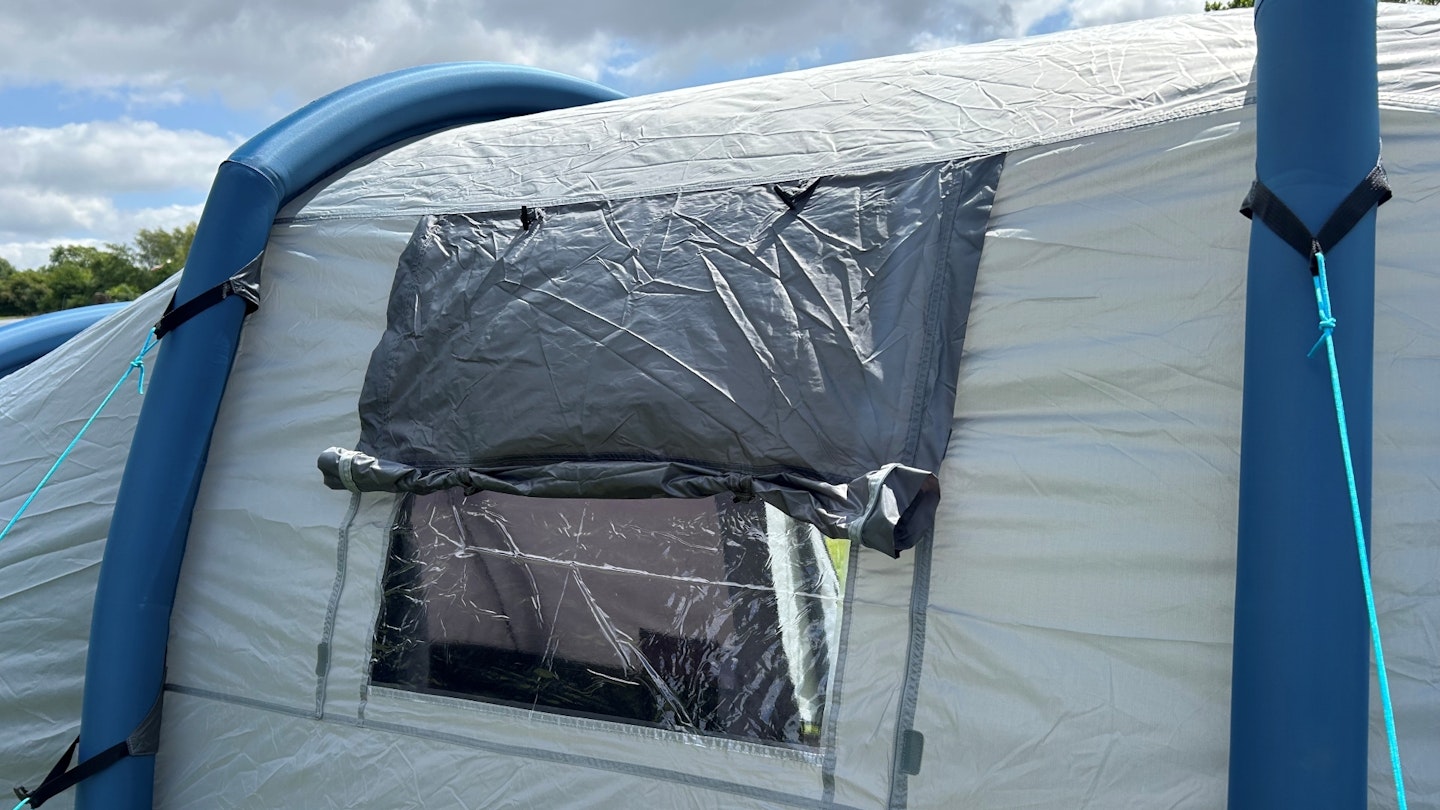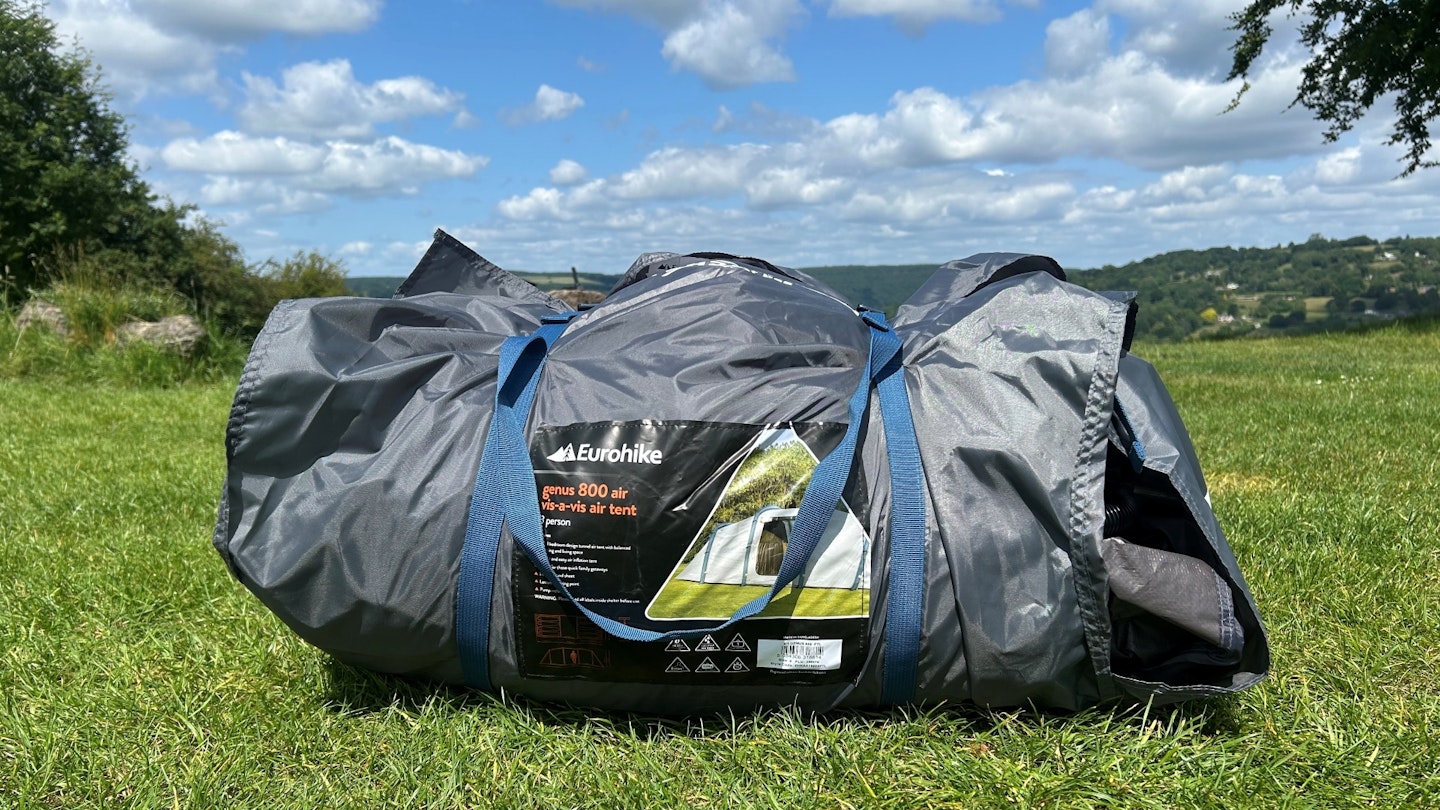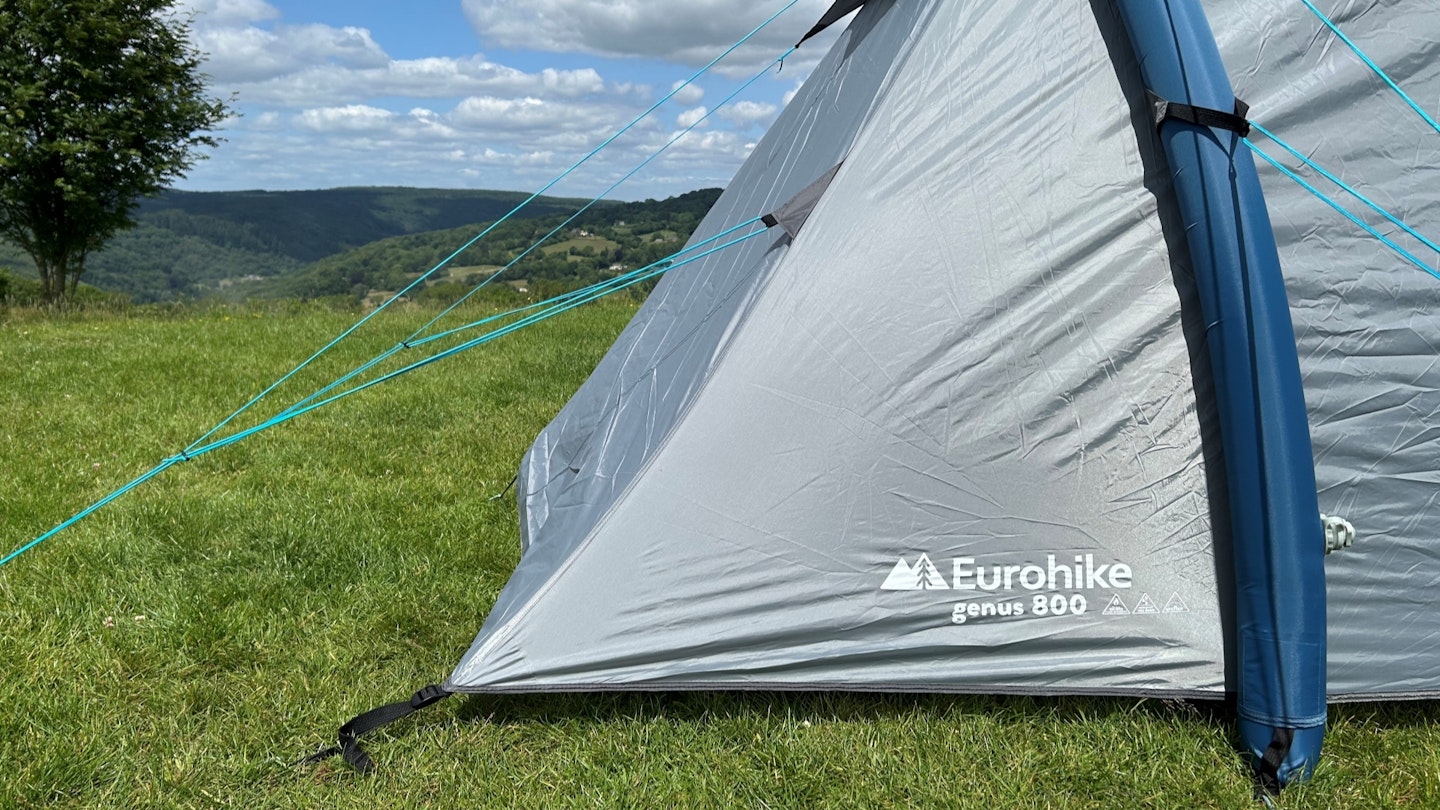There’s a beautiful simplicity in symmetry, something that Eurohike clearly understood when designing the Genus 800 Air Tent. This eight-person family tent features a central living space flanked by two identical blackout bedrooms or, as I liked to call them, the West Wing and the East Wing.
As an inflatable tent, it uses four air beams rather than traditional tent poles to achieve its structure and its simple, yet effective design makes it a breeze to pitch in no time at all. At 12.8kg, it's also remarkably light for this kind of tent, and packs down exceptionally small too.
While weight and packed size aren’t the be-all-and-end-all when it comes to car camping tents, the Genus 800 is light enough for one person to carry – a real benefit, especially if you’re packing it for festivals like Glastonbury or Bestival. And while it’s RRP is £850, it’s easy to find it for a fraction of this if you shop around.
So, what’s the catch? Well, firstly, calling this an eight-person tent is a bit of a stretch. The living area is relatively small – it’d hardly accommodate eight people taking shelter from a sudden storm with any degree of comfort.
This is because a greater proportion of the overall footprint is given to the bedrooms than in most family tents – though even these are not as wide as I’d like for four people in each. It’s also perhaps not quite as robust as some. Nevertheless, this is a well-designed family shelter that provides more separation from the little ones than those with a segregated main sleeping space.
“I told you to stay in the West Wing until 9am at the earliest!” etc etc.
Pros
- Two separate bedrooms
- Impressively compact and lightweight
- Wonderfully quick and easy to pitch
- Interior storage compartments
Cons
- Smaller living area than some
- Bedrooms not roomy enough for twin doubles
- Slightly uninspiring colour
| RRP: | £850 |
| Internal dimensions: | 595 x 250cm |
| Internal peak height: | 190cm |
| Packed size: | 73 x 38 x 36cm |
| Weight: | 12.8kg / 2st |
Shape, structure, pitching and internal liveability
The Genus 800 is a tunnel tent that makes use of four air beams to achieve its shape, rather than traditional poles. The central pair form twin upright arches that hold the main living space aloft either side of the main entrance.
Meanwhile, the side beams form diagonally angled arches to the left and right, holding the sloping roofs of the bedrooms up. Aesthetically, it wears its beams with pride, an exterior skeleton, invertebrate-esque.
In terms of its overall shape, imagine if Ayers Rock was an uninspiring grey, was made from polyester and was straddled by four blue tubes and you’re about there.

Unlike many tunnel tents that open from both one end and the side, the Genus 800 has only one side entrance. This brings you into the central living space, which measures 250 x 145cm and is 190cm tall. It’s admittedly not the largest, but there’s still room for a camping table and camping chairs.
However, as already alluded too, dinner for eight hungry campers would be quite a squeeze on a rainy day. Many four-, five-, six- and other eight-person family tents have a larger living area – so this is perhaps a tent for shorter camping holidays. With only two windows on either side of the living space, it’s also not the brightest or airiest family tent around.
Either side of the living space are the twin blackout bedrooms, which measure 240 x 225cm, large enough for four adults sleeping side-by-side, though this would leave precious little room to swing a cat.
Most double airbeds are wider than 120cm, too, which means the rooms aren’t big enough for a twin-double setup. I’d say, given the overall size of the living space and bedrooms, it’s a tent best suited for between four and six people.

A real selling point of this tent is how quickly and fuss-free it pitches. Eurohike boasts a 15-minute pitch and I found that I could make it habitable after 12 minutes and fully set up, guylines and all, in half-an-hour – pretty fast for a shelter of this size.
The pump is included, which isn’t always the case with inflatable tents, and having pegged out the corners, I found it was easy to inflate the beams.
There’s no awning to assemble or additional supports to piece together with this tent, so it was straight onto pegging everything else out, once the beams had taken shape.
Waterproofing
The Genus 800’s flysheet has a hydrostatic head (HH) rating of 3,000mm, which means that it should stand up to all but the most atrocious conditions Britain can, and will, throw at it. For the uninitiated, a fabric’s HH rating is the result of a lab test to determine the quantity of water it takes to compromise the fabric.
An open-ended tube is placed against the fabric and filled with water – the amount of water present in the tube when it starts to seep through the fabric is what provides the HH rating. So, in the case of the Genus 800’s flysheet, it can withstand a column of 3,000mm of water before giving up the ghost. It’s a decent rating too, above average when it comes to tent fabrics.

It's a bit of a cliché in the outdoor gear world, but there’s more to waterproofing than hydrostatic head ratings alone. Taped seams are present in the Genus 800, as you’d expect, providing an additional layer of protection at these potential lines of weakness.
I found that the slopes walls of the Genus 800 were great at shedding the drink, keeping everything dry, though I didn’t experience any truly Biblical downpours. However, given the stats and the quality of the tent’s construction, I’d back it when faced with anything up to one of those named storms that sweep in off the Atlantic.
Condensation
The living room windows, one on the back wall and one on the main entrance, contain a panel of mesh that creates a nice amount of airflow. Similarly, both bedroom windows feature a large mesh panel for letting air move freely while keeping tiny terrors like midges, ticks and mosquitos out.
There are exterior flysheet vents at both far ends of the tent, which can be adjusted by manipulating the guylines. Then, there’s the fact that the living space’s groundsheet isn’t sewn in, leaving a somewhat breezy gap around the bottom.
This created the necessary airflow for muggy summer evenings, creating a pleasant sleeping environment. It certainly gets the thumbs up from me on this score.

Wind protection
Unlike some, Eurohike doesn’t state the tent’s wind performance against criteria like the Beaufort scale. However, with its sturdy beams and array of guylines, I found that it coped perfectly well with moderate winds – the sort you’re likely to encounter in a relatively sheltered campsite.
I found that pitching the tent in parallel with the prevailing winds helped, as it’s more aerodynamic this way around, with less surface area for the wind to catch like a ship’s sail. However, the sloped nature of all its sides meant that it stood firm regardless of how it was pitched.
It’s important not to tension the guylines to the point where the beams begin to warp, as this has a negative impact on the overall stability.
Weight and packed size
For an eight-person (sort of) air tent, the Genus 800 is remarkably light, weighing just 12.8kg. To put this into context, that’s less than half the weight of the premium, five-person Outwell Colorado 5 Air and 2kg less than Decathlon’s Quechua 4-Man Inflatable Blackout Tent.

I found it easy to lug it about, without my veins straining against the skin of my temples as when hauling some family tents around. Quite how Eurohike kept the weight so low is beyond me. As well as being blessedly lightweight, the Genus 800 occupies less of a car boot than most similarly sized tents, with a packed size of 73 x 38 x 36cm. Its stuff sack is also fantastic…
One of my pet hates is badly designed tent carry sacks, particularly when it comes to stuffing large family tents into them. Eurohike’s solution is its simple but effective Easy Pack system. Rather than a bag, it’s basically a foldable sheet of fabric shaped like a + sign.
Each of the four arms feature straps and buckles, allowing you to tighten everything up once the tent was packed up, deposited on the central sheet and wrapped up. It's by far the best system in our current roundup of air tents.
Features

The main entrance features zippers on each side, meaning you can open up just one side if sneaking in and out during a deluge, or open the whole thing up on sunny days. The door has a two-part window – the top half is made of mosquito mesh, while the bottom is a transparent plastic.
On the opposite side to the main door is another two-part window. Both this and the door’s window have an exterior flysheet flap with Velcro that covers the window at night and can be folded away during the day using toggles.
It’s a bit of a faff having to leave the tent to manipulate these exterior flaps, particularly if (as I did), you’ve settled in for the night, taken your shoes off and then realised you’ve left both open.
Usefully, both bedrooms, as well as the living space, feature hooks for hanging a lantern and enjoying a spot of reading or pre-adventure faff at night. You can also pop your books, maps, power banks and camping gadgets in the two side storage compartments found in each bedroom.

Here, you’ll also find repair patches – a nice touch that means they’re always to hand should the worst occur and you accidentally tear your tent’s flysheet with your multitool or similar.
Unlike some, the groundsheet isn’t sewn onto the flysheet, leaving a gap between the ground and the walls in the living space. This has both advantages and disadvantages.
As mentioned, it makes the tent refreshingly airy on stuffy July afternoons, but it also means that determined insects can penetrate the inner sanctum. Heaven forfend a swarm of Highland midges breaching the defences – it doesn’t bear thinking about.
Verdict
The Eurohike Genus 800 is a simple and effective inflatable tent that provides two separate bedrooms with handy features like hanging hooks and storage compartments – ideal for camping families. It’s also remarkably light and packable for a shelter this size and pitches in no time at all.
However, its living space is a little on the small side so, while it can technically sleep eight, for a comfortable camping experience between four and six people would be the sweet spot.
Shop this product
About the author

As a qualified Mountain Leader, avid wild camper and a family man, Alex enjoys camping in all its forms. An expert on all things outdoor gear, he’s been testing and reviewing camping kit and tents – from solo backpacking shelters to palatial family car camping tents – for many years.






